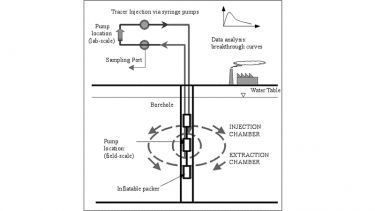Development of a novel in situ Aquifer Assessment Tool: The Dipole Flow and Reactive Tracer test
This project aims to develop a novel technique for simultaneous estimation of aquifer hydraulic, geochemical and biodegradation properties from a single borehole test.

Summary
The aim of this EPSRC funded project is to improve the risk based assessment and remediation of contaminated land through the development of a reliable method of site specific characterisation of reactive transport properties and their uncertainty supported by a cost/benefit calculator for the selection of site investigation tools.
The project will extend the recently developed dipole-flow test to include reactive tracers so that in situ reactive parameters required to support MNA can be estimated. This site characterisation test is called The Dipole Flow Reactive Tracer Test (DFRTT).
The key concept of the DFRTT is to characterise the subsurface using the fewest number of field tests by employing the latest innovations of science, engineering, and technology.
The DFRTT will be linked to remediation technology 'operating windows' concept for development of a Cost Benefit Analysis Calculator for planning SI - particularly related to assessing the feasibility of MNA at a site.
Project aims
- Develop and test the pump and packer system as a standard method for tracer injection and observation of breakthrough curves for the single borehole dipole.
- Develop and apply a numerical model for multi-species reactive transport in a radial flow field in order to design the field studies and interpret breakthrough curves.
- Carry out a laboratory programme to test tracers and to determine laboratory parameter values for aquifer properties that can be compared with values obtained in the field.
- Develop a risk assessment driven categorisation and catalogue of site investigation techniques.
- Develop a spreadsheet Cost-Benefit Analysis Calculator to optimise SI cost vs. SI performance, that includes the In Situ approach to obtain data to assess MNA, and to enable cost effective, conceptual model driven site investigation design.
Scientific approach
First, sandbox-scale physical model is constructed to investigate the behaviour of inert and reactive tracers within the dipole flow field. Then, a field programme is designed to proof DFRTT capabilities in the field.
A multi-phase reactive transport numerical model that interprets BTCs is developed to help planning field programme and evaluate laboratory and field results.
The Cost-Benefit-Analysis Calculator links outcomes of both laboratory and field investigations and provides quantitative decision support and determines the applicability of the AAT on a site-specific basis.
Project partners
- University of Sheffield
- Queens University Belfast
- University of Nottingham
- EPSRC
- Shell
- First Faraday
- BP
- Environment Agency.
